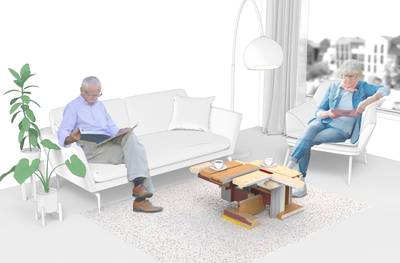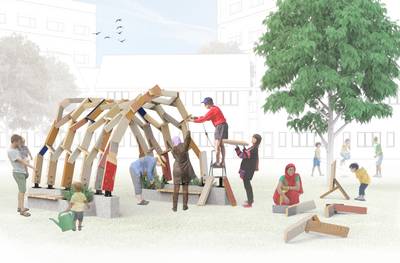Knowledge management (KM) is difficult to pin down. It means different things in different organisations. The deliberate use of metaphors has been used to communicate what KM is about. This metaphorical communication can be even more enriched using visual as well as language mechanisms: ”a picture paints a thousand words” suggests we can capture more resonances of a complex subject like KM through visuals than through a description alone. In addition, visuals are perceived to transcend the limitations of language, which can be an obstacle to communication. Yet, no method currently exists that we can use to identify KM metaphors used in visuals. This paper describes our search for a method to analyse metaphors used in visuals about knowledge management. Our objective was threefold: 1) identifying new metaphors for KM in visuals that can enrich KM theorizing, 2) developing a way to identify which visuals are the most powerful in communicating KM theory, and 3) improving the use of visuals as a way of assessing students studying KM. We found that analysing metaphors used in KM visuals is possible using a method that focuses on the dominant metaphors in a visual.
DOCUMENT

DOCUMENT
LINK
In the project 'Circular Wood for the Neighborhood', carried out by the Digital Production Research Group and partners, three cases were researched, each of them including prototyping. This output concerns the visuals (including AR-model) for the first case study.
IMAGE

In the project 'Circular Wood for the Neighborhood', carried out by the Digital Production Research Group and partners, three cases were researchEd, each of them including prototyping. This output concerns the visuals (including AR-model) for the third case study.
IMAGE

In the project 'Circular Wood for the Neighborhood', carried out by the Digital Production Research Group and partners, three cases were researched, each of them including prototyping. This output concerns the visuals (including AR-model) for the first case study.
IMAGE

Background: The integrated uptake of patient-reported experience measures, using outcomes for the micro, meso and macro level, calls for a successful implementation process which depends on how stakeholders are involved in this process. Currently, the impact of stakeholders on strategies to improve the integrated use is rarely reported, and information about how stakeholders can be engaged, including care-users who are communication vulnerable, is limited. This study illustrates the impact of all stakeholders on developing tailored implementation strategies and provides insights into supportive conditions to involve care-users who are communication vulnerable. Methods: With the use of participatory action research, implementation strategies were co-created by care-users who are communication vulnerable (n = 8), professionals (n = 12), management (n = 6) and researchers (n = 5) over 9 months. Data collection consisted of audiotapes, reports, and researchers’ notes. Conventional content analysis was performed. Results: The impact of care-users concerned the strategies’ look and feel, understandability and relevance. Professionals influenced impact on how to use strategies and terminology. The impact of management was on showing the gap between policy and practice, and learning from previous improvement failures. Researchers showed impact on analysis, direction of strategy changes and translating academic and development experience into practice. The engagement of care-users who are communication vulnerable was supported, taking into account organisational issues and the presentation of information. Conclusions: The impact of all engaged stakeholders was identified over the different levels strategies focused on. Care-users who are communication vulnerable were valuable engaged in co-creation implementation strategies by equipping them to their needs and routines, which requires adaptation in communication, delimited meetings and a safe group environment. Trial registration: Reviewed by the Medical Ethics Committee of Zuyderland-Zuyd (METCZ20190006). NL7594 registred at https://www.trialregister.nl/. Plain English summary Exploring care-users experiences is important for decisions to improve quality of care. This applies to care-users in the disability care in particular, as these care-users are highly dependent on their care professional. Instruments that facilitate a dialogue between care-users and care professionals about experiences with care are not always used correctly. Furthermore, it is difficult to translate outcomes into decisions about improving quality of care for the individual care-user and the organisation. In our study, care-users, care professionals, management and researchers developed strategies together to improve the use of care-user experience measures. This study aims to show the impact of all participants, including care-users, professionals, management and researchers, on developing implementation strategies. Additionally, the study aims to show how care-users can participate in developing strategies whilst having problems with communication due to intellectual, developmental and acquired disabilities. We found that care-users gave crucial input to the look and feel, and understandability and relevance of the strategies. The contribution of the professionals had impact on how to use strategies and terminology used in instructions and visuals. Management shared lessons learned and represented the needs on the policy level. Researchers used their analytical skills and facilitated the group process. Care-users were able to collaborate by taking into account their needs and because information was presented to them clearly and attractively.
DOCUMENT

Veel bedrijven staan reeds via social media als Facebook of Twitter in contact met hun gebruikers en iedere serieuze marketingcampagne werkt tegenwoordig met likes en tweets. Hoeveel ze daarin investeren en in de toekomst willen blijven doen, hangt af van de effectiviteit van social media. Maar wanneer zijn social media effectief, wat bepaalt die effectiviteit en hoe kunnen we die meten? Het zijn deze vragen waarop het project The Network = the Message zich richt. In de eerste fase van dit tweejarige onderzoekstraject is in kaart gebracht hoe social media campagnes nu worden ingezet en op welke wijze online netwerken worden geactiveerd. In december 2015 en januari 2016 hebben daartoe twaalf diepte-interviews plaats gevonden met de bureaus die deelnemen aan het project The Network is the Message.
MULTIFILE

This special issue of Systems Research and Behavioural Science is about the systematic use of metaphor and its implications for behaviour, especially in the field of knowledge management.
DOCUMENT

The current work on visual material in tourism studies ignores for the most part its aesthetic dimension as writers concentrate on the content of the image rather than its form. This paper argues that aesthetic considerations should be accorded more importance in tourism studies, as critical appreciation requires judgment and because discussion of form, not just content, is appropriate for the analysis of visuals. Furthermore, an approach to research which concentrates on aesthetics encourages greater individuality and independence. The paper has at its centre the writer's attempts to produce a series of 24, 60-second clips in Bangkok in August 2010, not necessarily in the style of the maestro of the city film, Dziga Vertov, but in his spirit.
LINK